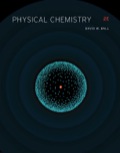
EBK PHYSICAL CHEMISTRY
2nd Edition
ISBN: 8220100477560
Author: Ball
Publisher: Cengage Learning US
expand_more
expand_more
format_list_bulleted
Concept explainers
Question
Chapter 12, Problem 12.13E
Interpretation Introduction
Interpretation:
The six coordinates that are used to determine
Concept introduction:
In
Where,
•
•
•
Expert Solution & Answer
Want to see the full answer?
Check out a sample textbook solution
Students have asked these similar questions
Show work. don't give Ai generated solution
Show work. Don't give Ai generated solution
Part A
Give the IUPAC name and a common name for the following ether:
CH3-CH2-O-CH2-CH2-CH3
Spell out the full names of the compound in the indicated order separated by a comma.
Submit
My Answers Give Up
Part B
Give the IUPAC name and a common name for the following ether:
Spell out the full names of the compound in the indicated order separated by a comma.
Submit
My Answers Give Up
Chapter 12 Solutions
EBK PHYSICAL CHEMISTRY
Ch. 12 - In the Stern-Gerlach experiment, silver atoms were...Ch. 12 - Prob. 12.2ECh. 12 - Prob. 12.3ECh. 12 - Suppose s=12 for an electron. Into how many parts...Ch. 12 - Using and labels, write two possible...Ch. 12 - List all possible combinations of all four quantum...Ch. 12 - What are the degeneracies of the H atom...Ch. 12 - Prob. 12.8ECh. 12 - a Differentiate between the quantum numbers s and...Ch. 12 - Is the spin orbital 1s for the H atom still...
Ch. 12 - Draw a diagram analogous to Figure 11.15, but now...Ch. 12 - Are mathematical expressions for the following...Ch. 12 - Prob. 12.13ECh. 12 - Prob. 12.14ECh. 12 - a Assume that the electronic energy of Li was a...Ch. 12 - Spin orbitals are products of spatial and spin...Ch. 12 - If 1 and 2 are the individual wavefunctions for...Ch. 12 - Show that the correct behavior of a wavefunction...Ch. 12 - Prob. 12.19ECh. 12 - Why isnt the electron configuration of beryllium,...Ch. 12 - Prob. 12.21ECh. 12 - Write a Slater determinant for the lithide ion,...Ch. 12 - Why does the concept of antisymmetric...Ch. 12 - a Construct Slater determinant wavefunctions for...Ch. 12 - Prob. 12.25ECh. 12 - Prob. 12.26ECh. 12 - Prob. 12.27ECh. 12 - Suppose an electron had three possible values of...Ch. 12 - Using a periodic table or Table 12.1, find the...Ch. 12 - Write an acceptable electron configuration for...Ch. 12 - Prob. 12.31ECh. 12 - Prob. 12.32ECh. 12 - Prob. 12.33ECh. 12 - An anharmonic oscillator has the potential...Ch. 12 - Prob. 12.35ECh. 12 - In a particle-in-a-box having length a, the...Ch. 12 - Prob. 12.37ECh. 12 - Prob. 12.38ECh. 12 - Prob. 12.39ECh. 12 - The Stark effect is the change in energy of a...Ch. 12 - Prob. 12.41ECh. 12 - Prob. 12.42ECh. 12 - Prob. 12.43ECh. 12 - Show that a variation theory treatment of H using...Ch. 12 - Prob. 12.45ECh. 12 - Explain why assuming an effective nuclear charge,...Ch. 12 - Prob. 12.47ECh. 12 - Consider a real system. Assume that a real...Ch. 12 - Prob. 12.49ECh. 12 - Prob. 12.50ECh. 12 - Prob. 12.51ECh. 12 - Prob. 12.52ECh. 12 - State the Born-Oppenheimer approximation in words...Ch. 12 - Prob. 12.54ECh. 12 - Spectroscopy deals with differences in energy...Ch. 12 - Prob. 12.56ECh. 12 - What is the bond order for the lowest excited...Ch. 12 - The helium atom was defined as two electrons and a...Ch. 12 - Explain how we know that the first in equation...Ch. 12 - Prob. 12.60ECh. 12 - Prob. 12.61ECh. 12 - Use molecular orbital arguments to decide whether...Ch. 12 - Prob. 12.63ECh. 12 - Prob. 12.65ECh. 12 - Prob. 12.67ECh. 12 - Prob. 12.68E
Knowledge Booster
Learn more about
Need a deep-dive on the concept behind this application? Look no further. Learn more about this topic, chemistry and related others by exploring similar questions and additional content below.Similar questions
- Frenkel and Schottky are intrinsic or extrinsic defects, point or linear defects.arrow_forwardSelect the correct option:a) Frenkel and Schottky defects are linear crystal defects.b) Schottky defects involve atomic motions in a crystal lattice.c) Frenkel defects are vacancies in a crystal lattice.d) None of the above is correct.arrow_forwardThe most common frequency in organic chemistry is the Select one: Oa. carbon-oxygen single bond Ob. None of the above Oc. carbon-carbon double bond Od. carbon-carbon single bondarrow_forward
arrow_back_ios
SEE MORE QUESTIONS
arrow_forward_ios
Recommended textbooks for you
- Chemistry: Matter and ChangeChemistryISBN:9780078746376Author:Dinah Zike, Laurel Dingrando, Nicholas Hainen, Cheryl WistromPublisher:Glencoe/McGraw-Hill School Pub Co
 Chemistry for Engineering StudentsChemistryISBN:9781337398909Author:Lawrence S. Brown, Tom HolmePublisher:Cengage Learning
Chemistry for Engineering StudentsChemistryISBN:9781337398909Author:Lawrence S. Brown, Tom HolmePublisher:Cengage Learning General Chemistry - Standalone book (MindTap Cour...ChemistryISBN:9781305580343Author:Steven D. Gammon, Ebbing, Darrell Ebbing, Steven D., Darrell; Gammon, Darrell Ebbing; Steven D. Gammon, Darrell D.; Gammon, Ebbing; Steven D. Gammon; DarrellPublisher:Cengage Learning
General Chemistry - Standalone book (MindTap Cour...ChemistryISBN:9781305580343Author:Steven D. Gammon, Ebbing, Darrell Ebbing, Steven D., Darrell; Gammon, Darrell Ebbing; Steven D. Gammon, Darrell D.; Gammon, Ebbing; Steven D. Gammon; DarrellPublisher:Cengage Learning  ChemistryChemistryISBN:9781305957404Author:Steven S. Zumdahl, Susan A. Zumdahl, Donald J. DeCostePublisher:Cengage Learning
ChemistryChemistryISBN:9781305957404Author:Steven S. Zumdahl, Susan A. Zumdahl, Donald J. DeCostePublisher:Cengage Learning Chemistry: An Atoms First ApproachChemistryISBN:9781305079243Author:Steven S. Zumdahl, Susan A. ZumdahlPublisher:Cengage Learning
Chemistry: An Atoms First ApproachChemistryISBN:9781305079243Author:Steven S. Zumdahl, Susan A. ZumdahlPublisher:Cengage Learning

Chemistry: Matter and Change
Chemistry
ISBN:9780078746376
Author:Dinah Zike, Laurel Dingrando, Nicholas Hainen, Cheryl Wistrom
Publisher:Glencoe/McGraw-Hill School Pub Co

Chemistry for Engineering Students
Chemistry
ISBN:9781337398909
Author:Lawrence S. Brown, Tom Holme
Publisher:Cengage Learning

General Chemistry - Standalone book (MindTap Cour...
Chemistry
ISBN:9781305580343
Author:Steven D. Gammon, Ebbing, Darrell Ebbing, Steven D., Darrell; Gammon, Darrell Ebbing; Steven D. Gammon, Darrell D.; Gammon, Ebbing; Steven D. Gammon; Darrell
Publisher:Cengage Learning

Chemistry
Chemistry
ISBN:9781305957404
Author:Steven S. Zumdahl, Susan A. Zumdahl, Donald J. DeCoste
Publisher:Cengage Learning

Chemistry: An Atoms First Approach
Chemistry
ISBN:9781305079243
Author:Steven S. Zumdahl, Susan A. Zumdahl
Publisher:Cengage Learning

The Bohr Model of the atom and Atomic Emission Spectra: Atomic Structure tutorial | Crash Chemistry; Author: Crash Chemistry Academy;https://www.youtube.com/watch?v=apuWi_Fbtys;License: Standard YouTube License, CC-BY